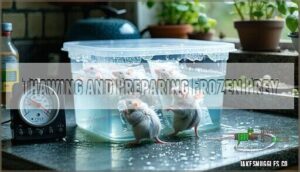This site is supported by our readers. We may earn a commission, at no cost to you, if you purchase through links.
 Learning how to care for a pet snake starts with nailing the basics: temperature, humidity, and feeding.
Learning how to care for a pet snake starts with nailing the basics: temperature, humidity, and feeding.
You’ll need to maintain a thermal gradient of 75-95°F using under-tank heaters and thermostats. Keep humidity between 50-60% for most species.
Feed appropriately-sized frozen-thawed prey every 1-2 weeks—your snake’s body width determines prey size. Handle gently after they’ve digested, supporting their body weight.
Watch for signs of illness like mites, respiratory infections, or stuck shed. Create hiding spots on both warm and cool sides of the enclosure.
The secret lies in species-specific requirements that can make or break your success.
Table Of Contents
- Key Takeaways
- Setting Up The Ideal Snake Habitat
- Maintaining Optimal Temperature and Humidity
- Feeding Your Pet Snake
- Handling and Interacting With Your Snake
- Monitoring Snake Health and Wellness
- Frequently Asked Questions (FAQs)
- How to care for a snake for beginners?
- What I wish I knew before getting a snake?
- How often should I clean my snakes enclosure?
- What size enclosure does my snake need?
- Can different snake species be housed together?
- How do I safely transport my pet snake?
- What signs indicate my snake is ready to shed?
- How long do pet snakes typically live?
- What are the initial costs of snake ownership?
- Can snakes be kept together in pairs?
- Conclusion
Key Takeaways
- Set up proper temperature zones – You’ll need a warm side at 85-95°F and a cool side at 75-80°F, using under-tank heaters with thermostats to prevent dangerous overheating.
- Feed frozen-thawed prey correctly – You should offer appropriately sized rodents every 1-2 weeks, matching prey width to your snake’s thickest body section for safe digestion.
- Maintain 50-60% humidity levels – You’ll need to monitor with a hygrometer and use water bowls, misting systems, or humid hideboxes to support proper shedding.
- Handle gently and watch for health issues – You should support your snake’s body weight during handling and monitor for signs, such as respiratory problems, mites, or stuck shed, that require veterinary attention.
Setting Up The Ideal Snake Habitat
Creating the perfect snake habitat starts with understanding your pet’s specific needs and mimicking their natural environment.
Your snake deserves a home that mirrors nature’s perfect balance.
You’ll need to balance several critical factors including enclosure size, temperature control, humidity levels, substrate selection, and enrichment features to keep your snake healthy and comfortable, focusing on complete concepts such as these to ensure a well-rounded environment.
Choosing The Right Enclosure Size
Your snake’s enclosure setup starts with getting the size right. The terrarium size should match your snake length—at least equal to your pet’s full body length.
A cramped snake tank creates stress and limits natural movement.
Space requirements matter for your pet reptiles’ wellbeing:
- Stretching freedom – Your snake needs room to fully extend its body
- Natural behavior – Adequate enclosure depth allows normal exploration patterns
- Stress reduction – Proper tank setup prevents restrictive behaviors
- Growth accommodation – Ventilation needs increase with larger enclosures
Standard adult snakes thrive in 48" x 24" x 24" enclosures.
Providing a suitable environment involves understanding snake welfare principles to guarantee the best life for your pet.
Essential Equipment for Temperature Control
Your temperature control setup can make or break your snake’s health.
Heat mats provide consistent baseline warmth, while heat lamps create those vital basking spots your snake craves.
Thermostats prevent dangerous overheating by regulating all heat sources automatically.
Proper heat mat selection is crucial for maintaining ideal temperatures, and understanding heat mat types is essential for creating a suitable environment with the right heat mat products.
| Equipment | Purpose | Temperature Range |
|---|---|---|
| Heat Mats | Belly heat for digestion | 85-90°F |
| Ceramic Emitters | 24/7 ambient warmth | 78-85°F |
| Heat Lamps | Daytime basking spots | 88-92°F |
| Thermostats | Automatic temperature control | Species-specific |
| Temperature Gauges | Monitoring hot/cool zones | Accurate readings |
Understanding the different equipment and their purposes is key to creating a healthy environment for your snake, with thermostats playing a critical role in preventing overheating and ensuring the snake’s overall well-being through automatic temperature control.
Creating Proper Humidity Levels
Proper humidity control transforms your terrarium into a thriving ecosystem. Research your species’ specific needs—ball pythons crave 50-60% while corn snakes prefer 40-50%. Monitor levels with a reliable hygrometer and adjust accordingly.
- Position large water bowls on the warm side to increase natural evaporation
- Install misting systems for consistent moisture without oversaturation
- Add humid hideboxes with damp sphagnum moss for shedding support
Selecting Appropriate Substrate Materials
Something this important deserves careful consideration—your snake substrate choice affects everything from cleaning ease to your pet’s comfort.
Aspen shavings excel at moisture absorption and burrowing, while coconut fiber retains humidity beautifully for tropical species. Bark mulch offers natural aesthetics but costs more.
Reptile carpet provides easy cleaning but limited enrichment. Match your terrarium substrate to your snake’s natural habitat needs.
Avoid cedar or pine shavings, which contain harmful oils. The right substrate options create a foundation for your snake’s health and happiness.
Researching proper snake substrate is vital for maintaining a healthy environment.
Providing Hiding Spots and Enrichment
Creating the right hiding spots transforms your snake’s habitat from a glass box into a secure home.
Your pet needs both physical security and mental stimulation to thrive.
Essential hiding places include:
- Hollow logs or cork bark for natural cover
- Climbing structures like branches for exercise
- Fake plants providing visual barriers
- Basking rocks for temperature regulation
These enrichment activities reduce stress while encouraging natural behaviors.
Place hiding spots on both warm and cool sides for ideal comfort.
Maintaining Optimal Temperature and Humidity
Your snake’s health depends on mastering temperature control and humidity regulation. Set up distinct climate zones within the enclosure—a warm side at 85-95°F and a cool side at 75-80°F.
This temperature gradient allows proper thermoregulation as your snake moves between areas. Use under-tank heaters or ceramic heat emitters as primary heat sources. Monitor snake temperature with digital thermometers on both ends.
Maintain humidity levels between 50-60% for most species using a quality hygrometer. Accurate hygrometer monitoring is essential for maintaining these levels.
| Temperature Zone | Ideal Range | Monitoring Tool |
|---|---|---|
| Warm Side | 85-95°F | Digital thermometer |
| Cool Side | 75-80°F | Digital thermometer |
| Humidity | 50-60% | Hygrometer |
| Night Drop | 5-10°F lower | Thermostat timer |
Choose moisture-retaining substrates like cypress mulch for humidity regulation. Mist lightly when needed, but avoid over-saturating. Proper reptile temperature control prevents respiratory infections and shedding problems.
Your snake enclosure setup should include thermostats to prevent dangerous temperature spikes.
Feeding Your Pet Snake
Feeding your pet snake correctly is vital for its health and longevity.
Understanding your snake’s dietary needs and establishing proper feeding routines will help prevent common health issues and guarantee your pet thrives.
Understanding Snake Dietary Needs
All pet snakes are obligate carnivores requiring whole prey items for ideal snake nutrition.
Your snake’s dietary needs depend on species, age, and size. Proper prey selection guarantees complete nutritional balance without supplements.
Essential snake feeding tips:
- Rodents provide complete protein – mice and rats supply all necessary nutrients
- Frozen-thawed prey is safest – eliminates injury risks from live feeding
- Whole prey prevents deficiencies – bones, organs, and muscle meet all requirements
For optimal health, understanding snake nutrition needs is vital for pet owners.
Choosing The Right Prey Size
Getting prey size right is like finding the perfect fit – too small and your snake stays hungry, too large and it can’t swallow properly.
Match the prey’s width to your snake’s thickest body section for ideal snake nutrition.
Frozen "Arctic Mice" and similar rodent selection options work well for most species.
Proper prey items guarantee healthy digestion and support your snake’s natural feeding behavior patterns.
Many snake owners rely on frozen mouse food sources for convenient feeding solutions.
Proper Feeding Techniques and Schedules
Adult snakes typically eat every 1-2 weeks, while juveniles need twice weekly meals.
Use feeding tongs to offer prey items safely, wiggling them to trigger your snake’s hunting instincts.
Feed in a separate container to prevent substrate ingestion and establish routine.
Monitor your snake’s behavior – quick consumption signals proper meal frequency.
Never handle during digestion periods.
Thawing and Preparing Frozen Prey
Now that you’ve mastered feeding schedules, proper prey preparation makes all the difference. Place frozen prey in a sealed bag and thaw in the refrigerator overnight—this method preserves nutritional quality while preventing bacterial growth.
Before feeding, warm the prey to 95-100°F using warm water to trigger your snake’s natural feeding response. Following proper thawing techniques is vital for maintaining the quality of frozen snake food and preventing bacterial growth, which is why understanding safe thawing methods is essential.
- Thaw mice for 2 hours, rats need 4-6 hours in the fridge
- Use leak-proof bags to prevent waterlogging during thawing
- Change thawing water every 30 minutes to prevent bacteria
- Check for cold spots in prey before serving
- Discard any uneaten thawed prey—never refreeze it, as this can lead to bacterial growth and reduce the nutritional quality of the food.
Addressing Feeding Problems
Four common feeding issues can disrupt your snake’s routine.
When your snake shows food refusal, try switching prey species or adjusting size.
Digestive problems often cause appetite loss, so monitor for regurgitation or constipation.
Review your feeding schedule and prey items for errors.
Most snake feeding troubles resolve with patience and proper technique adjustments.
Handling and Interacting With Your Snake
Proper handling creates a positive relationship between you and your snake while ensuring both of your safety.
You’ll need to learn specific techniques and recognize your snake’s body language to build trust over time.
Proper Handling Techniques for Safety
Now that you’ve mastered feeding your snake, handling techniques require equal attention to safety.
Use a snake hook for safe removal from the enclosure. Support your snake’s body evenly along its length, never grabbing just the head or tail.
Think gentle restraint, not wrestling—snakes respond better to calm, confident handling. Keep sessions short initially while building trust.
Recognizing Signs of Stress in Snakes
Your snake’s body language speaks volumes about their comfort level.
Watch for restlessness and frequent escape attempts – these are clear stress symptoms. Hissing, striking, or constant movement during daylight hours signals discomfort, especially in nocturnal species.
Refusing food for multiple feedings is a well-documented stress response that can last weeks. Rapid, jerky movements and excessive tongue flicking indicate anxiety.
Environmental factors like inadequate hides or incorrect temperature cause these behaviors, leading to serious health issues if ignored.
Building Trust With Your Pet Snake
Trust building requires patience and consistency.
Success comes from patient, consistent interactions that respect your snake’s natural boundaries and comfort levels.
Start slow with your snake, spending time near their enclosure before attempting gentle handling.
Use proper snake handling techniques, supporting their body while avoiding sudden movements.
Watch for snake recognition signs like reduced defensive posturing.
Practice calming techniques and trust exercises through regular, brief interactions.
Your snake will gradually associate your presence with safety, making snake interaction more enjoyable for both of you.
Safe Socialization Practices
Beyond basic snake handling, successful socialization requires creating calm environments where your pet feels secure.
Gentle touch and consistent routines build trust over time. Always wash your hands before and after handling, support your snake’s body fully, and limit sessions to 10-15 minutes to prevent stress.
Watch for signs of discomfort like hissing or tight coiling.
These snake handling techniques help establish social bonding:
- Your snake’s comfort zone becomes your guide – respecting their boundaries creates lasting trust
- Each gentle interaction builds confidence – transforming fear into curiosity through patient snake socialization
- Success feels like freedom – when your snake relaxes in your hands, you’ve mastered trust building
Monitoring Snake Health and Wellness
Keeping your snake healthy requires regular observation and proactive care to catch potential issues early.
You’ll need to monitor everything from eating patterns to shedding cycles while establishing a relationship with a qualified reptile veterinarian, which is crucial for maintaining your snake’s overall health and well-being.
Common Health Issues in Pet Snakes
Understanding these health challenges helps you protect your snake companion effectively.
Respiratory Issues affect up to 70% of captive snakes, causing wheezing and open-mouth breathing.
Parasite Control becomes essential since 47% of pet snakes harbor internal parasites.
Snake Mites and Skin Infections create visible discomfort, while Metabolic Problems affect bone development in growing snakes.
| Health Issue | Primary Cause | Impact on Your Snake |
|---|---|---|
| Respiratory Problems | Poor humidity/temperature | Breathing difficulties, lethargy |
| Parasitic Infestations | Contaminated environment | Weight loss, digestive issues |
| Mouth Rot | Stress, poor nutrition | Eating problems, systemic infection |
| Shedding Problems | Low humidity | Vision issues, skin infections |
These snake health issues require prompt attention but remain manageable with proper snake care basics.
Recognizing Signs of Illness
Early detection saves lives.
Watch for these critical snake health issues:
- Respiratory Issues – Wheezing, mouth breathing, or mucus discharge
- Skin Lesions – Blisters, discolored patches, or abnormal swelling
- Eye Problems – Cloudy eyes, discharge, or retained shed skin
- Digestive Issues – Regurgitation, bloating, or unusual bowel movements
- Stress Symptoms – Lethargy, jerky movements, or appetite loss
These snake diseases require immediate veterinary attention for proper pet snake care.
Shedding Process and Assistance
Shedding Tips become second nature once you understand your snake’s molting process. Watch for cloudy eyes and behavioral changes—these signal snake shedding is approaching.
Humidity Control is your secret weapon; boost levels to 70-80% during this time. Create Shedding Aids like damp hiding spots or rough surfaces for rubbing.
If stuck shed appears, Snake Soaking in lukewarm water helps, but never force removal. The snake shedding process takes 1-2 weeks from start to finish.
Proper Skin Care through Shedding Support guarantees your snake emerges healthy and comfortable.
Regular Health Check Routines
Your snake’s health depends on consistent monitoring. Think of yourself as a detective, watching for clues that signal trouble before it becomes serious.
Regular wellness checks help you spot problems early.
- Weight tracking: Use a digital scale monthly to catch gradual changes
- Behavioral patterns: Monitor eating habits, activity levels, and hiding preferences
- Physical examination: Check scales, mouth, and eyes for abnormalities
- Waste monitoring: Note frequency and consistency of droppings
- Veterinary care: Schedule annual checkups with reptile-experienced vets
Parasite control and snake diseases require professional oversight. Most snake health issues develop slowly, making routine health monitoring your best defense.
These snake care routines become second nature with practice. By following a thorough snake health checklist, you can guarantee your pet snake leads a long and healthy life.
Finding a Reptile-Savvy Veterinarian
Locating quality reptile care professionals requires strategic veterinary search techniques.
The Association of Reptile and Amphibian Veterinarians maintains an international directory of qualified practitioners.
Board certification in reptile medicine represents the gold standard for vet credentials.
Local wildlife rescues and specialized pet stores provide valuable specialist referrals.
Don’t settle for general practitioners—your snake’s health demands expertise in reptile veterinary care and regular veterinary checkups from experienced snake care professionals.
Frequently Asked Questions (FAQs)
How to care for a snake for beginners?
Your slithery roommate needs surprisingly little fuss.
Set up a secure glass terrarium with proper heating, hiding spots, and substrate.
Feed frozen mice weekly, maintain 80-85°F temperatures, and handle gently after meals.
What I wish I knew before getting a snake?
You’ll underestimate initial setup costs—quality terrariums, heating systems, and thermostats aren’t cheap.
Temperature gradients matter more than you think; improper heating causes serious health issues.
Monthly feeding feels weird at first, but it’s normal.
How often should I clean my snakes enclosure?
Ever wonder how a messy cage affects your snake’s health?
You’ll need to spot-clean daily and do a full deep clean monthly.
Weekly disinfection of bowls and accessories keeps harmful bacteria at bay.
What size enclosure does my snake need?
Your snake needs an enclosure that’s at least 2/3 to twice its adult length. A 40-gallon tank works well for most adult corn snakes and similar species.
Can different snake species be housed together?
Like oil and water, different species simply don’t mix harmoniously. You shouldn’t house different snake species together—they’ll compete for resources, spread diseases, and create stress that compromises their health.
How do I safely transport my pet snake?
Use a secure, ventilated transport container with familiar substrate. Check temperature controls and avoid sudden movements. Never transport in pockets or loose bags—your snake needs proper support during travel.
What signs indicate my snake is ready to shed?
Back in medieval times, shedding was nature’s armor upgrade.
You’ll notice your snake’s eyes turn milky blue, skin becomes dull and cloudy, and it’ll refuse food while seeking rough surfaces to rub against.
How long do pet snakes typically live?
Most pet snakes live 10-30 years depending on their species. Ball pythons and corn snakes often reach 20-25 years with proper care, while some larger species can live even longer.
What are the initial costs of snake ownership?
Initial snake ownership costs range from $200- You’ll need a 40-gallon terrarium ($100-200), heating equipment ($50-100), substrate and hides ($30-50), plus your snake ($50-300 depending on species).
Can snakes be kept together in pairs?
Most snakes aren’t social butterflies; they’re solitary creatures who prefer their own space. Housing them together often leads to stress, competition, and potential cannibalism. Keep them separate for their well-being.
Conclusion
Like a well-oiled machine, successful snake care depends on consistent attention to detail.
You’ve learned how to care for a pet snake through proper habitat setup, temperature control, feeding schedules, and health monitoring.
Remember that each species has unique requirements, so research your specific snake’s needs thoroughly, and start with the basics and build your confidence gradually.
Your snake will thrive with proper care, patience, and dedication to their wellbeing.
- https://www.corhs.org/index.php?get=content&pageid=105
- https://www.chewy.com/education/reptile-and-amphibian/snake/snake-housing
- https://www.youtube.com/watch?v=W4bE2jE6sDo
- https://www.petsmart.com/learning-center/reptile-care/how-to-feed-your-snake/A0166.html
- https://www.rspca.org.uk/adviceandwelfare/pets/other/cornsnake



















